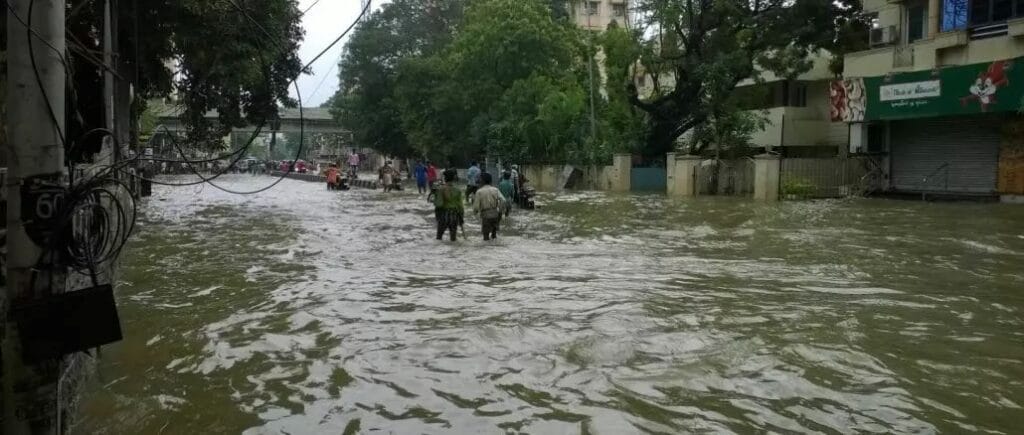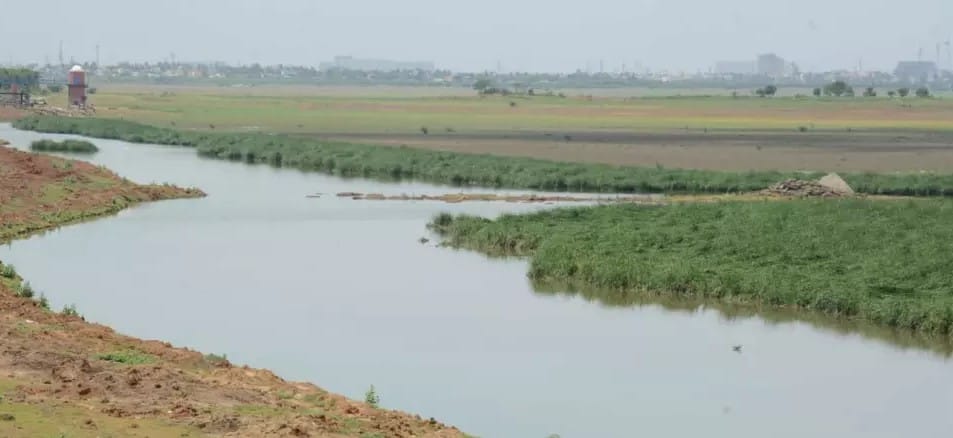Chennai received one of its worst rains in the last 80 years in December 2023*, and we should not be surprised if the city is primed to break more such records in the future for the worse. The scenes of boats out on the streets, families stranded on rooftops, and news media outlets asking what happened to all the funds sanctioned for building stormwater drains are painfully familiar for Chennai come monsoon-cyclones season.
Since 2015, this ‘water-stressed’ city has endured brutal cycles of extreme rainfall and destructive flooding, most recently from Cyclone Michaung. The 2015 deluge saw nearly 50 cm of rain in 24 hours, causing at least 250 deaths and widespread devastation to the tune of US $ 3 billion. According to a UN report, this was one of the costliest disasters in Chennai’s history. When Cyclone Vardah hit Chennai in 2016, it uprooted over 8,000 trees.
Electricity and transport infrastructure suffered damages of over US $ 500 million. Not to forget a similar catastrophe that the city experienced just two years ago. Between December 3rd and 5th of last year, Chennai recorded over 38 cm of rain as the cyclone made landfall along the Tamil Nadu coast. Experts analysing a 48-hour window for peak rainfall contend the intensity had surpassed prior record-breaking levels.
Read more: Water, water everywhere, but where’s the storage space?
Too much water in too little time: Chennai’s tryst with floods

Research confirms floods and cyclones are worsening because of climate change, yet authorities in Chennai continue planning for urban and industrial expansion, disregarding the possibility of such a water reality — as if reactionary measures are truly enough.
Despite civil society agitations and climate activism, the voices of those who stand to lose the most from such city development and growth mindsets often do not penetrate the space for planning and action. For many citizens, who barely recovered from past floods, especially fisherfolk and other marginalised communities residing in Ennore Creek and along the floodplains of Paalar and Adyar, the recent flood has compounded their loss and trauma.
Yet, the city keeps expanding its concrete footprint, trading its blue and green space for the well-being of a select few. This begs pressing questions — will Chennai continue this trajectory of inflated development clashing with increasingly extreme weather? Can the city govern its growth in a way that works with, not against, the rising water-related extreme events?
The city and its water commons
Pitting concrete against our lakes and waterways continues to set this city up for failure. The answer then lies in collaborating with nature, not conquering it. But, what if I told you the lakes of Chennai were us collaborating with nature, long before we started building over them? The call to revisit our relationship with the city’s waterscape is a call to learn from our long past and ask what it means to reinvent those relationships in ways that are meaningful.
Water commons include all waters that rest and flow — in the form of lakes, wetlands, rivers, canals, and groundwater — which are principally non-exclusionary in terms of access and require high forms of participatory governance for their successful management.
This requires looking beyond just stormwater infrastructure to ask deeper questions about reducing our exposure versus treating vulnerabilities in the aftermath of such devastating events. We must turn to our traditional ery (lake) systems — interconnected, cascading, man-made water bodies built across the city’s landscape to guide the water slowly towards the sea, making sure it ‘walks’ slowly rather than rushes uncontrollably.
These ‘water commons’ were created and managed by agrarian communities, which saw seasonal floods as opportunities for storage that benefited fields, so that the relationship between a place and its floods was often symbiotic. In places like Velachery, Perumbakkam and Pallikaranai, where once lake storage and flows were highly regulated and managed to meet agrarian interests, overflowing lakes now devastate neighbourhoods and set vehicles afloat.
Reviving the wisdom of this hydrological approach could transform how Chennai withstands floods in the future Retrofitting strategies for stormwater planning and downstream displacement must occur within a broader attempt to revisit how we understand, measure, plan for and govern our waters — and what this means for our lakes and wetlands. The city must learn again, how to live with water.
Charting water positive futures

We must examine what lessons we can learn from our socio-hydrological past, and from climate science-based predictions for our future water relations. For instance, ensuring proper drainage and flood management of the Pallikaranai area requires proper identification, mapping and maintenance of the 65 upstream lakes connected to the marsh, and the water pathways they follow, till they drain into the sea.
Read more: Of bullock carts, wells, fountains and reservoirs: Water supply in Chennai through the centuries
Call to action—
- A comprehensive solution requires both state-level planning and grassroots civic engagement. State agencies must collaborate on water-sensitive planning to map Chennai’s drainage holistically while reinforcing lakes and wetlands as vital infrastructure to absorb heavy rains.
- Citizens must share the responsibility to manage and safeguard these connected water systems; keeping lake bunds clear of debris, remaining vigilant against misuse, and actively fostering local stewardship of waterbodies for conservation and community recreation.
- Bottom-up civic participation reinforces top-down mapping and policies to integrate the city’s hydrology into its urban planning and development plans. The state, civil society and other local stakeholders must unite to uphold such an approach and hold political will accountable for steering us onto this path.
- We must adopt a holistic and sensitive approach to urban water governance, which leaves room for overflow, restores lakes and wetlands’ retention capacity, and ensures marginalised settlements are out of harm’s way.
While groups such as Care Earth Trust, Palliyur Trust and Chennai Climate Action Group have long championed various dimensions of water-sensitive development, from climate education to rights-based conservation, the onus remains on all of us as citizens to demand and enable such a shift. None of these options may seem easy or convenient, but climate and civic inaction only courts further disaster.
If Chennai cannot live harmoniously with water, it may not live at all. While the city’s future resilience depends deeply on restoring its water balance, we must have hope this balance can be struck. Our shared humanity calls us to forge more just relations with each other and our living landscapes — relations where both people and nature can thrive amid uncertainty. By learning from past wisdom and present science to transform how we see, plan for and interact with our water commons, Chennai still has a chance to chart water-positive futures where we stand with, not against, the rising tides.
*Errata: The date had been mentioned as December 2024 in the first published version, and has been corrected later. We apologise for the error.